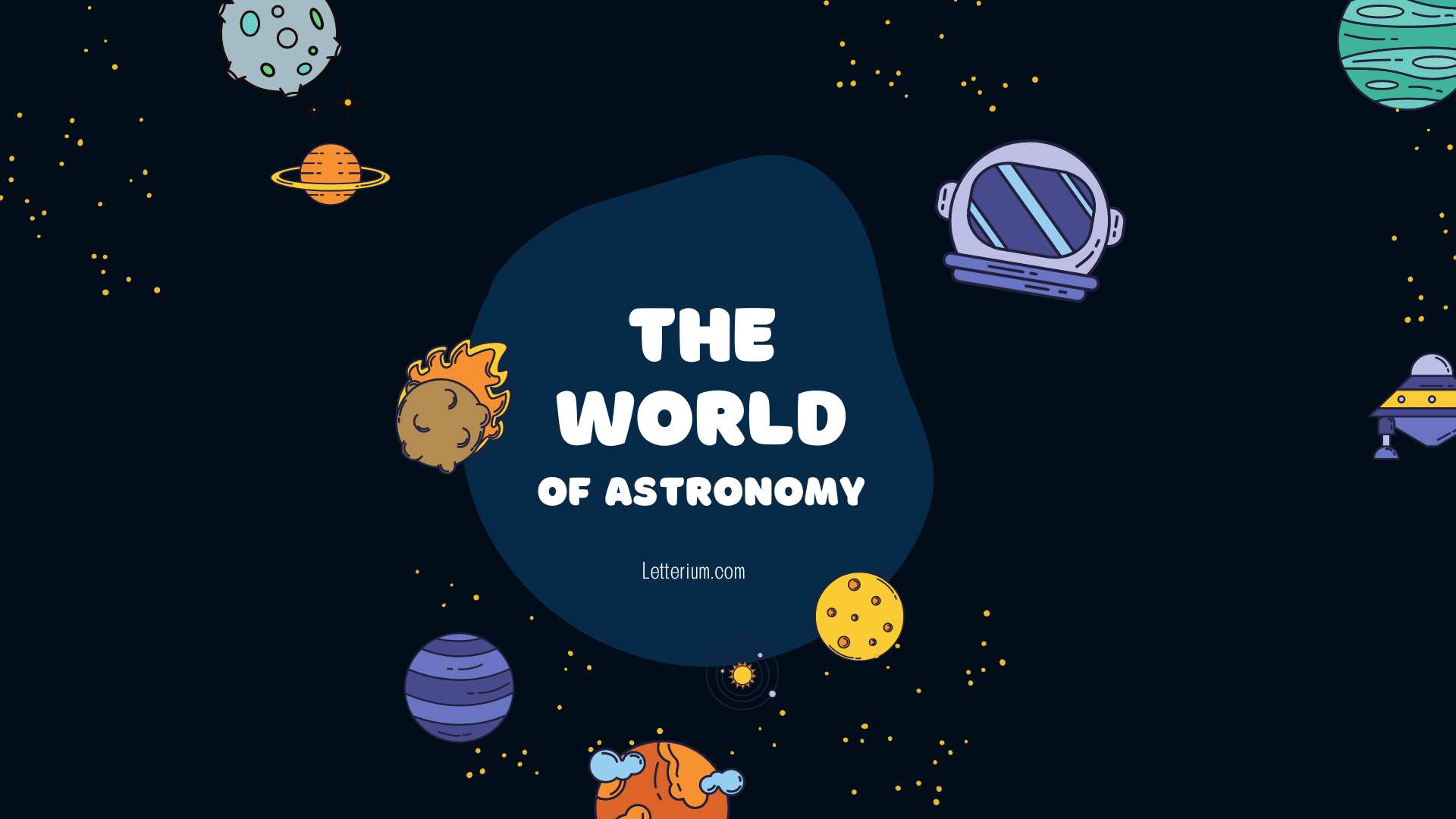Astronomy, the oldest of the natural sciences, is the study of celestial objects and phenomena that originate outside Earth's atmosphere. It involves the observation and understanding of stars, planets, comets, galaxies, and the cosmos as a whole. Unlike its sibling science, astrology, which seeks to find meaning in the movements of celestial bodies, astronomy is grounded in rigorous, observational science and aims to understand the laws governing the universe.
What is Astronomy?

Astronomy is the scientific study of celestial objects and phenomena that exist outside the Earth's atmosphere. This includes the observation and analysis of stars, planets, moons, galaxies, comets, nebulae, cosmic radiation, and the universe as a whole. The discipline encompasses a broad range of research areas, including the physics, chemistry, and evolution of celestial objects, as well as the formation and development of the universe itself.
Unlike astrology, which is the belief system that suggests human affairs and terrestrial events are influenced by the movements and positions of celestial objects, astronomy is a rigorous science. It relies on mathematics, physics, and chemistry to explain the origins and behaviors of the cosmos. Astronomy is one of the oldest sciences, with origins dating back to ancient civilizations that used the predictable patterns of the heavens for navigation, timekeeping, and ceremonial purposes.
Astronomers use a variety of instruments to study the universe, from ground-based telescopes to space telescopes, satellites, and probes. These tools allow them to collect data across different wavelengths of light (from radio waves to gamma rays), providing a comprehensive view of the universe's complex dynamics.
The field is divided into several branches, including:
- Observational astronomy: The practice of observing celestial objects and phenomena, using telescopes and other astronomical instruments to gather data.
- Theoretical astronomy: The development of computational and analytical models to describe astronomical objects and phenomena.
- Astrophysics: A branch that applies the principles of physics and chemistry to explain the birth, life, and death of stars, planets, galaxies, and other celestial bodies.
- Cosmology: The study of the universe as a whole, including its origins, evolution, structure, and eventual fate.
Astronomy's goals include understanding the universe's structure and history, the physical laws that govern it, the formation and development of celestial bodies, and the potential for life elsewhere in the universe. It is a continually evolving field, with discoveries regularly expanding our knowledge and challenging our understanding of the cosmos.
The Historical Journey of Astronomy
The historical journey of astronomy is a fascinating tale of human curiosity, ingenuity, and the relentless pursuit to understand the cosmos. This journey spans thousands of years, from ancient civilizations to the cutting-edge research of the modern era.
Ancient Beginnings
Astronomy is arguably the oldest science, with its roots deeply embedded in the efforts of ancient civilizations to comprehend the celestial sphere. Early humans looked to the heavens to navigate, keep time, and even explain their place in the universe. Monumental structures like Stonehenge in England and the pyramids of Egypt are testament to the astronomical knowledge of our ancestors.
Babylonians and Greeks
The Babylonians were among the first to record their observations of the heavens, developing a calendar based on the cycles of the Moon and identifying patterns that would later be known as the zodiac. Greek astronomers, such as Aristarchus of Samos, proposed early models of the solar system, suggesting that the Earth orbits the Sun. However, it was Ptolemy's geocentric model that prevailed for centuries, placing Earth at the center of the universe.
The Renaissance and the Copernican Revolution
The Renaissance brought a renewed interest in science and the natural world, setting the stage for the Copernican Revolution. In 1543, Nicolaus Copernicus published "De revolutionibus orbium coelestium," which argued for a heliocentric model with the Sun at the center of the universe. This idea challenged the prevailing Ptolemaic model and laid the groundwork for modern astronomy.
The Advent of the Telescope
The invention of the telescope in the early 17th century marked a significant leap forward. Galileo Galilei, often called the father of observational astronomy, used the telescope to make groundbreaking discoveries, including the moons of Jupiter and the phases of Venus, providing strong evidence for the Copernican system.
The Newtonian Revolution
Isaac Newton's laws of motion and universal gravitation, published in "Principia Mathematica" in 1687, revolutionized astronomy. Newton's work offered a mathematical framework for the motion of celestial bodies, firmly establishing the heliocentric model and paving the way for the prediction of celestial events.
The 19th and 20th Centuries: Expansion of Knowledge
The 19th and 20th centuries saw an explosion of discoveries in astronomy, facilitated by technological advances in telescopes and the advent of astrophotography. Astronomers identified new planets, such as Neptune, and discovered galaxies beyond the Milky Way, expanding our understanding of the universe's vastness.
The Modern Era
The 20th century also ushered in the era of space exploration, with the launch of satellites and manned missions to space, including the Apollo moon landings. The Hubble Space Telescope, launched in 1990, has provided unprecedented views of the universe, leading to discoveries such as the accelerating expansion of the universe.
The 21st Century and Beyond
Today, astronomy continues to evolve with advances in technology and methodology. Projects like the James Webb Space Telescope, set to launch in the near future, promise to peer further back in time than ever before, potentially unveiling the secrets of the early universe. Ground-based observatories, like the Extremely Large Telescopes, aim to image exoplanets directly and analyze their atmospheres for signs of life.
The historical journey of astronomy is a testament to humanity's enduring desire to understand the cosmos. From ancient astronomers charting the stars to modern scientists unraveling the mysteries of the universe, this journey is one of the greatest intellectual adventures, reflecting our collective quest for knowledge and our place within the cosmos.
Key Discoveries in Astronomy
The field of astronomy is rich with groundbreaking discoveries that have expanded our understanding of the universe and our place within it. These discoveries span from the identification of celestial bodies to the revelation of the universe's fundamental structure and dynamics. Here are some key discoveries in astronomy that have significantly influenced our knowledge of the cosmos:

1. The Heliocentric Model
One of the most pivotal moments in astronomy was the introduction of the heliocentric model by Nicolaus Copernicus in the 16th century. This model proposed that the Earth and other planets orbit the Sun, challenging the long-standing geocentric model that placed the Earth at the center of the universe. The heliocentric model laid the foundation for modern astronomy.
2. Galileo’s Telescopic Discoveries
Galileo Galilei's use of the telescope in the early 17th century led to several significant discoveries, including the four largest moons of Jupiter (Io, Europa, Ganymede, and Callisto), the phases of Venus, and the detailed observations of the Moon's surface. These findings provided strong evidence for the Copernican model and demonstrated that celestial bodies were not immutable heavenly objects but worlds with their own landscapes.
3. Newton’s Laws of Motion and Universal Gravitation
Isaac Newton's formulation of the laws of motion and the law of universal gravitation in the 17th century revolutionized our understanding of how celestial bodies move. His work showed that the same physical laws that govern motion on Earth also apply to the heavens, unifying celestial and terrestrial mechanics.
4. Discovery of Neptune
The prediction and subsequent discovery of Neptune in 1846 was a remarkable demonstration of the power of mathematical astronomy. Neptune was the first planet to be discovered through mathematical predictions rather than through observational astronomy, showcasing the predictive power of Newton's laws of motion.
5. Hubble’s Expansion of the Universe
In 1929, Edwin Hubble made the groundbreaking discovery that the universe is expanding. By observing the redshift in the light from distant galaxies, Hubble showed that galaxies are moving away from us in all directions. This discovery provided the foundation for the Big Bang theory, which describes the universe as expanding from a hot, dense state.
6. Cosmic Microwave Background Radiation
The discovery of the cosmic microwave background radiation in 1965 by Arno Penzias and Robert Wilson was a pivotal moment for cosmology. This faint microwave radiation, permeating the universe, is the afterglow of the Big Bang, providing strong evidence for the universe's origin in a hot, dense state approximately 13.8 billion years ago.
7. Exoplanets
The first confirmed detection of an exoplanet orbiting a sun-like star in 1995 marked the beginning of a new era in astronomy. Since then, thousands of exoplanets have been discovered, revealing the diversity of planetary systems and opening new avenues for the search for extraterrestrial life.
8. Gravitational Waves
The first direct detection of gravitational waves in 2015 by the LIGO and Virgo collaborations confirmed a major prediction of Albert Einstein's general theory of relativity. Gravitational waves, ripples in the fabric of spacetime caused by violent cosmic events, have opened a new window for observing the universe, providing insights into phenomena like black hole mergers.
9. Black Hole Imaging
In 2019, the Event Horizon Telescope project captured the first image of a black hole's event horizon, located in the center of the M87 galaxy. This historic image provided direct visual evidence of black holes' existence and offered insights into their properties and the dynamics of matter and light in their vicinity.
These discoveries, among many others, have profoundly changed our understanding of the universe. Each finding has built on the work of previous generations, illustrating the cumulative nature of scientific knowledge and the ongoing quest to unravel the mysteries of the cosmos.
Research and Analysis in Astronomy
Research and analysis in astronomy encompass a broad range of activities and methodologies aimed at understanding the universe and its myriad components. This field has evolved dramatically over the centuries, from the naked-eye observations of ancient astronomers to the sophisticated, data-driven investigations of today. The pursuit of astronomical knowledge today involves a combination of observational techniques, theoretical modeling, and computational simulations, each contributing unique insights into the workings of the cosmos.
Observational Astronomy
Observational astronomy is the foundation of research in the field. It involves collecting data about celestial objects and phenomena using telescopes and other instruments. These observations can be conducted across the entire electromagnetic spectrum, from radio waves to gamma rays, each providing different information about the universe.
- Optical and Radio Telescopes: Traditionally, optical telescopes have been used to observe visible light from stars and galaxies, while radio telescopes detect radio waves, offering insights into phenomena like cosmic microwave background radiation or the structure of galaxies.
- Space-Based Observatories: To avoid the distortive effects of Earth's atmosphere, space telescopes like the Hubble Space Telescope operate in orbit. They provide clearer and more detailed images of distant celestial objects in wavelengths that are absorbed or scattered by the atmosphere, including ultraviolet, X-ray, and gamma-ray.
- Interferometry: This technique combines signals from multiple telescopes to achieve the resolution of a much larger telescope, allowing astronomers to study celestial objects in unprecedented detail.
Theoretical Astronomy and Astrophysics
Theoretical astronomy involves developing models to explain observations and predict new phenomena. It relies heavily on mathematics, physics, and computer simulations to explore concepts such as stellar evolution, galaxy formation, cosmology, and the dynamics of celestial bodies.
- Numerical Simulations: Simulations are crucial for testing theories of how structures in the universe form and evolve. For example, simulations of the early universe can help astronomers understand the formation of galaxies and the distribution of dark matter.
- Analytical Modeling: This involves using mathematical equations to describe the behavior of celestial objects. Analytical models can predict the outcomes of celestial events, such as the orbits of planets or the evolution of stars.
Computational Astronomy
With the advent of powerful computers, computational astronomy has become a vital part of research. It involves processing and analyzing vast amounts of data from observations and simulations, using techniques from data science and machine learning.
- Data Processing: Observational data often require significant processing to remove noise and biases. Techniques like image stacking, signal processing, and calibration are essential for extracting useful information.
- Big Data and Machine Learning: The field of astronomy generates massive datasets, particularly from sky surveys that map the entire sky. Machine learning algorithms help in classifying objects, detecting patterns, and making predictions based on the data.
Interdisciplinary Research
Astronomy increasingly intersects with other scientific disciplines, including chemistry, biology, and geology, particularly in areas like astrochemistry, astrobiology, and planetary science. These intersections have led to new research avenues, such as the study of exoplanets' atmospheres for signs of life or the chemical processes that lead to the formation of complex organic molecules in space.
Key Areas of Current Research and Analysis
- Dark Matter and Dark Energy: Understanding the nature of dark matter and dark energy remains one of the biggest challenges. These mysterious components constitute most of the universe's mass-energy content but cannot be observed directly.
- Exoplanet Discovery and Characterization: The search for and study of exoplanets, especially those in the habitable zone of their stars, is a rapidly growing area of research, with implications for understanding planetary systems and the potential for life beyond Earth.
- Cosmology and the Early Universe: Research in cosmology aims to unravel the history of the universe from the Big Bang to the present, including the cosmic microwave background, the rate of the universe's expansion, and the formation of the first stars and galaxies.
Astronomy's research and analysis methods are continually evolving, driven by technological advancements and theoretical breakthroughs. This dynamic interplay of observation, theory, and computation propels our understanding of the universe forward, revealing the cosmos in ever-greater detail and complexity.
Fascinating Facts About Astronomy
Astronomy, with its vast and often incomprehensible scale, is a source of endless fascination. Here are some intriguing facts about the universe that highlight the awe-inspiring nature of the cosmos and the remarkable discoveries made by astronomers:

1. The Scale of the Observable Universe
The observable universe is approximately 93 billion light-years in diameter. Despite this vast expanse, it represents only a fraction of the entire universe, much of which remains beyond our observational capabilities due to the finite speed of light and the expansion of space.
2. The Age of the Universe
The universe is about 13.8 billion years old, a figure determined through observations of the cosmic microwave background radiation and measurements of the expansion rate of the universe, known as the Hubble constant.
3. Stars in the Milky Way
Our galaxy, the Milky Way, is home to about 100 to 400 billion stars. When you look up at the night sky, every star you see is part of the Milky Way. The galaxy itself is just one of potentially trillions in the observable universe.
4. The Concept of Light-Years
A light-year is the distance light travels in one year, roughly 9.46 trillion kilometers (about 5.88 trillion miles). This unit is used to express astronomical distances, illustrating the vastness of space. For example, the nearest star to Earth, Proxima Centauri, is about 4.24 light-years away.
5. Black Holes and Their Power
Black holes are regions of space where gravity is so strong that nothing, not even light, can escape. The first image of a black hole's event horizon (the boundary beyond which nothing can return) was captured in 2019, showcasing the power of these cosmic phenomena.
6. Neutron Stars: The Universe's Densities
Neutron stars, the remnants of supernova explosions, are incredibly dense. Just a sugar-cube-sized amount of neutron star material would weigh about as much as Mount Everest. These stars pack the mass of the Sun into a sphere only a few kilometers in diameter.
7. The Multitude of Exoplanets
Thousands of planets orbiting other stars (exoplanets) have been discovered in our galaxy alone. Some of these exoplanets are in the "habitable zone" of their star, where conditions might be right for liquid water—and potentially life—to exist.
8. Cosmic Microwave Background Radiation
The cosmic microwave background (CMB) radiation is the afterglow of the Big Bang, permeating the entire universe. This radiation provides a snapshot of the infant universe, allowing astronomers to understand more about its origins and evolution.
9. The Universe's Expansion
The universe is not just expanding; its expansion is accelerating. This discovery, made in the late 1990s, implies the existence of dark energy, a mysterious force driving this acceleration.
10. Galaxies Moving Away From Us
Every distant galaxy we observe is moving away from us, with galaxies farther away moving faster. This observation supports the Big Bang theory, suggesting that the universe started from a highly dense and hot state and has been expanding ever since.
These facts only scratch the surface of the fascinating discoveries and phenomena in astronomy. Each new observation and technological advancement brings us closer to understanding the mysteries of the universe, continually reminding us of its vastness and complexity.
The Future of Astronomy
The future of astronomy holds immense promise, driven by technological advancements, upcoming missions, and the ever-growing curiosity about the universe. Several key developments are poised to redefine our understanding of the cosmos in the coming decades:
Next-Generation Telescopes
The next generation of ground-based and space telescopes will offer unprecedented views of the universe. Ground-based telescopes, like the Extremely Large Telescope (ELT) in Chile, are expected to have mirrors over 30 meters in diameter, allowing astronomers to observe the first stars and galaxies and directly image exoplanets. Space telescopes, such as the James Webb Space Telescope (JWST), will study the universe in infrared, probing the atmospheres of exoplanets, observing the early universe, and exploring the life cycles of stars and galaxies.
Advancements in Space Exploration
Future space missions will continue to explore our solar system and beyond. Missions to Mars, such as NASA's Mars Sample Return mission, aim to bring samples back to Earth for detailed analysis. The exploration of icy moons like Europa and Enceladus, which harbor subsurface oceans, may reveal clues about the potential for life beyond Earth.
The Search for Extraterrestrial Life
One of the most exciting prospects in astronomy is the search for signs of life elsewhere in the universe. The upcoming generation of telescopes and missions will be equipped to detect biosignatures in the atmospheres of exoplanets, compounds that indicate the presence of life. Projects like the Breakthrough Listen Initiative are also expanding the search for intelligent extraterrestrial communications.
Dark Matter and Dark Energy Research
Understanding the nature of dark matter and dark energy remains a significant challenge. These mysterious components make up most of the universe's mass-energy content but are not directly observable. Future observations and experiments, including large-scale sky surveys and particle physics experiments, aim to uncover their properties.
Multi-Messenger Astronomy
The field of multi-messenger astronomy, which combines observations of light, gravitational waves, and particles like neutrinos, is rapidly expanding. This approach provides a more comprehensive understanding of cosmic events, such as neutron star mergers, and opens new avenues for exploring the universe.
Big Data and Artificial Intelligence
The astronomical data collected by observatories and space missions are increasing exponentially. Artificial intelligence and machine learning techniques are becoming essential tools for processing and analyzing this data, helping to identify patterns, classify objects, and make discoveries at a pace unimaginable a few decades ago.
Interdisciplinary Collaborations
The future of astronomy will likely see increased collaboration between disciplines, including physics, chemistry, biology, and computer science. These interdisciplinary approaches are crucial for answering complex questions about the universe, from the nature of dark matter to the potential for life on other planets.
Public Engagement and Education
Advances in technology and communication will continue to democratize access to astronomical data and discoveries. Public engagement initiatives, citizen science projects, and educational programs will play a vital role in inspiring the next generation of astronomers and fostering a global appreciation for the science of the cosmos.
The future of astronomy is not just about the technological advancements and the new discoveries they will bring but also about the broader impact on our understanding of the universe and our place within it. As we stand on the brink of these exciting developments, the journey of discovery is bound to deepen our appreciation of the cosmos and unlock secrets that have puzzled humanity for centuries.
Conclusion
The exploration of astronomy, from its ancient origins to the cutting-edge research of the modern era, reveals a journey of human curiosity, intellectual bravery, and relentless pursuit of knowledge. This journey has not only expanded our understanding of the cosmos but has also profoundly transformed our perspective on our place within it. The key discoveries in astronomy, spanning from the realization that Earth orbits the Sun to the detection of exoplanets and the imaging of black holes, underscore the vastness and complexity of the universe.
The methodologies of research and analysis in astronomy—observational, theoretical, and computational—have evolved alongside technological advancements, enabling astronomers to probe deeper into the cosmos than ever before. These efforts have unveiled phenomena that challenge our understanding and inspire further inquiry, highlighting the dynamic and ever-expanding nature of astronomical science.
The fascinating facts about astronomy, from the scale of the observable universe to the mysteries of dark matter and dark energy, remind us of the universe's profound mysteries. These facts not only captivate our imagination but also fuel the relentless quest for knowledge that defines the field.
Looking ahead, the future of astronomy holds unparalleled potential for discovery. With next-generation telescopes, innovative space missions, and the burgeoning field of multi-messenger astronomy, we stand on the brink of new frontiers in our understanding of the universe. These advancements promise not only to unravel the mysteries of dark matter, dark energy, and the potential for life beyond Earth but also to further challenge our conceptual grasp of the cosmos.
In conclusion, the field of astronomy embodies the human desire to explore, understand, and connect with the cosmos. It is a testament to our ability to reach beyond our immediate surroundings and contemplate the universe in its grandeur and complexity. As we continue to push the boundaries of knowledge, the journey of astronomy will undoubtedly inspire future generations, fostering a deeper appreciation of the universe and our shared humanity within it.


 English
English 
